The NVIDIA GeForce GTX 780 Ti Review
by Ryan Smith on November 7, 2013 9:01 AM ESTCompute
Jumping into compute, we’re entering the one area where GTX 780 Ti’s rule won’t be nearly as absolute. Among NVIDIA cards its single precision performance will be unchallenged, but the artificial double precision performance limitation as compared to the compute-focused GTX Titan means that GTX 780 Ti will still lose to GTX Titan whenever double precision comes into play. Alternatively, GTX 780 Ti still has to deal with the fact that AMD’s cards have shown themselves to be far more competitive in our selection of compute benchmarks.
As always we'll start with our DirectCompute game example, Civilization V, which uses DirectCompute to decompress textures on the fly. Civ V includes a sub-benchmark that exclusively tests the speed of their texture decompression algorithm by repeatedly decompressing the textures required for one of the game’s leader scenes. While DirectCompute is used in many games, this is one of the only games with a benchmark that can isolate the use of DirectCompute and its resulting performance.
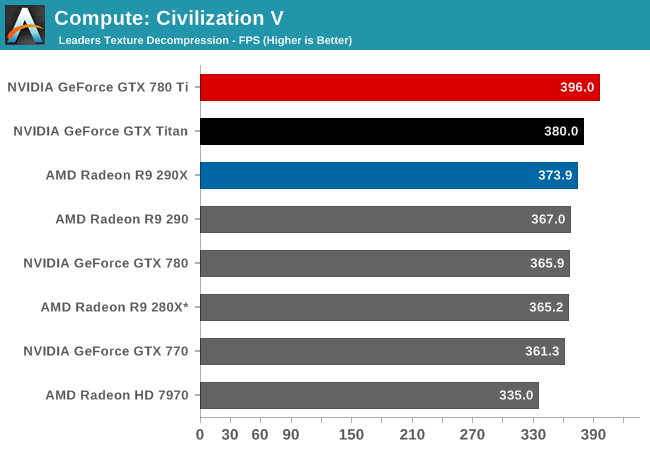
Even though we’re largely CPU bound by this point, GTX 780 Ti manages to get a bit more out of Civilization V’s texture decode routine, pushing it to the top of the charts and ahead of both GTX Titan and 290X.
Our next benchmark is LuxMark2.0, the official benchmark of SmallLuxGPU 2.0. SmallLuxGPU is an OpenCL accelerated ray tracer that is part of the larger LuxRender suite. Ray tracing has become a stronghold for GPUs in recent years as ray tracing maps well to GPU pipelines, allowing artists to render scenes much more quickly than with CPUs alone.
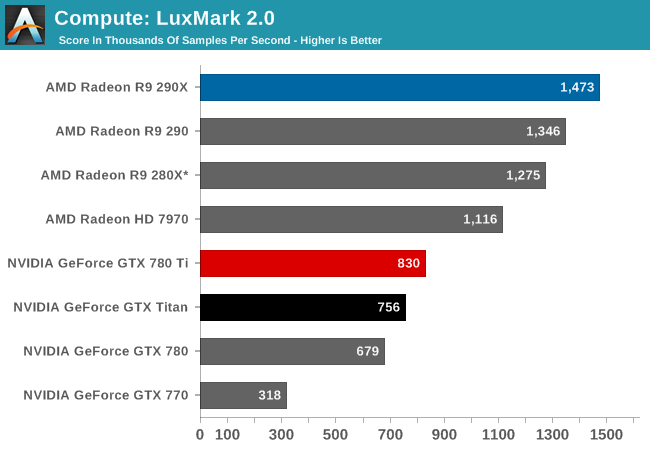
With LuxMark NVIDIA’s ray tracing performance sees further improvements due to the additional compute resources at hand. But NVIDIA still doesn’t fare well here, with the GTX 780 Ti falling behind all of our AMD cards in this test.
Our 3rd compute benchmark is Sony Vegas Pro 12, an OpenGL and OpenCL video editing and authoring package. Vegas can use GPUs in a few different ways, the primary uses being to accelerate the video effects and compositing process itself, and in the video encoding step. With video encoding being increasingly offloaded to dedicated DSPs these days we’re focusing on the editing and compositing process, rendering to a low CPU overhead format (XDCAM EX). This specific test comes from Sony, and measures how long it takes to render a video.

Like LuxMark, GTX 780 Ti once again improves on its predecessors. But it’s not enough to make up for AMD’s innate performance advantage in this benchmark, leading to GTX 780 Ti trailing all of the AMD cards.
Our 4th benchmark set comes from CLBenchmark 1.1. CLBenchmark contains a number of subtests; we’re focusing on the most practical of them, the computer vision test and the fluid simulation test. The former being a useful proxy for computer imaging tasks where systems are required to parse images and identify features (e.g. humans), while fluid simulations are common in professional graphics work and games alike.
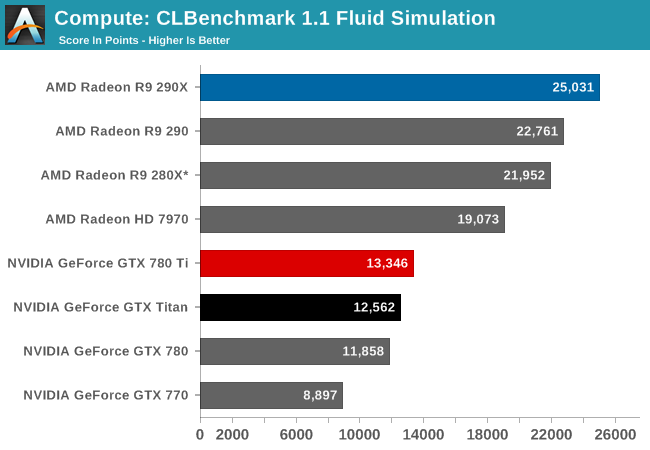
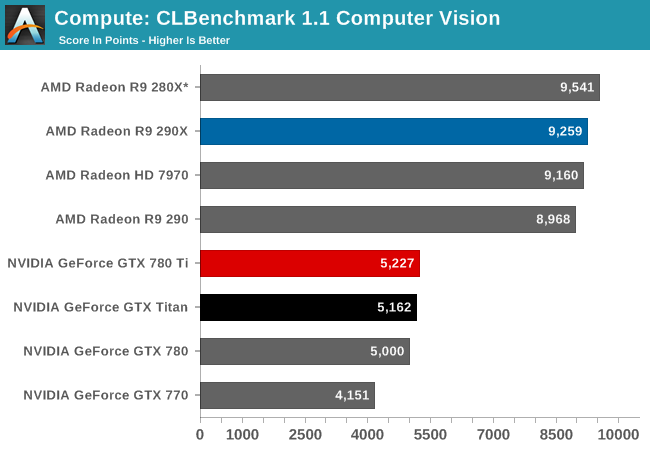
CLBenchmark continues to be the same story. GTX 780 Ti improves on NVIDIA’s performance to become their fastest single precision card, but it still falls short of every AMD card in these tests.
Moving on, our 5th compute benchmark is FAHBench, the official Folding @ Home benchmark. Folding @ Home is the popular Stanford-backed research and distributed computing initiative that has work distributed to millions of volunteer computers over the internet, each of which is responsible for a tiny slice of a protein folding simulation. FAHBench can test both single precision and double precision floating point performance, with single precision being the most useful metric for most consumer cards due to their low double precision performance. Each precision has two modes, explicit and implicit, the difference being whether water atoms are included in the simulation, which adds quite a bit of work and overhead. This is another OpenCL test, as Folding @ Home has moved exclusively to OpenCL this year with FAHCore 17.

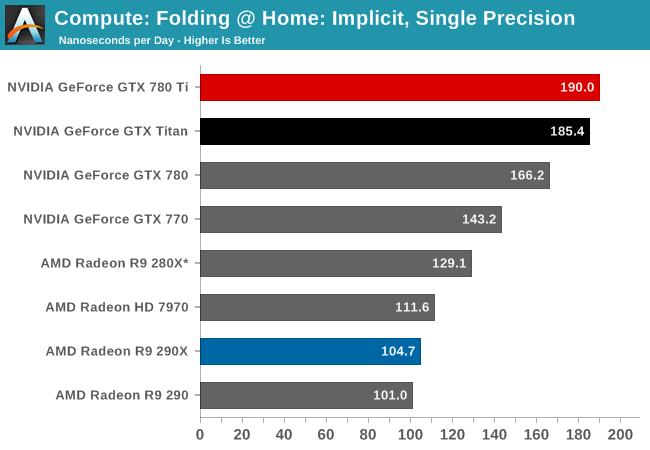
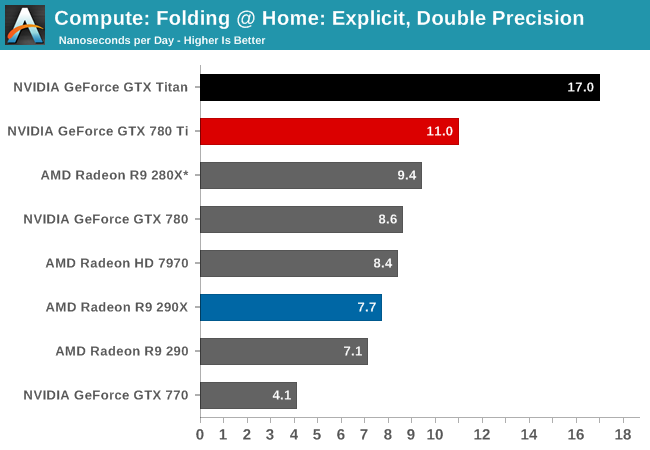
Finally with Folding@Home we see the GTX 780 Ti once again take the top spot. In the single precision tests the GTX 780 further extends NVIDIA’s lead, beating GTX Titan by anywhere between a few percent to over ten percent depending on which specific test we’re looking at. However even with GTX 780 Ti’s general performance increase, in the double precision test it won’t overcome the innate double precision performance deficit it faces versus GTX Titan. When it comes to double precision compute, Titan remains king.
Wrapping things up, our final compute benchmark is an in-house project developed by our very own Dr. Ian Cutress. SystemCompute is our first C++ AMP benchmark, utilizing Microsoft’s simple C++ extensions to allow the easy use of GPU computing in C++ programs. SystemCompute in turn is a collection of benchmarks for several different fundamental compute algorithms, as described in this previous article, with the final score represented in points. DirectCompute is the compute backend for C++ AMP on Windows, so this forms our other DirectCompute test.
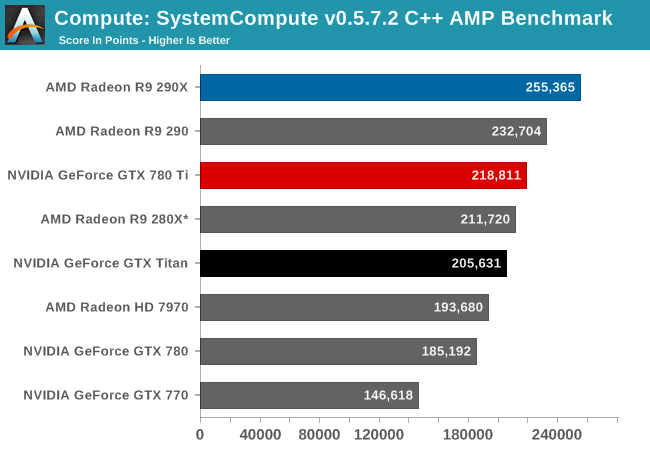
Last, in our C++ AMP benchmark we see the GTX 780 Ti take the top spot for an NVIDIA card, but like so many of our earlier compute tests it will come up short versus AMD’s best cards. This isn’t quite as lopsided as some of our other tests, however GTX 780 Ti is stuck competing with the 280X while the 290 and 290X easily outperform NVIDIA’s new flagship.










302 Comments
View All Comments
r13j13r13 - Friday, November 8, 2013 - link
a los fans de NVIDIA no se preocupen pronto sacaran la version de 1000 dolares con un 5% mas de rendimientotwtech - Friday, November 8, 2013 - link
An interesting comparison would be a 780 Ti vs. crossfired 290s. In the previous generation of cards, I wouldn't have considered that fair, as any type of SLI/crossfire setup was definitely inferior to any single-card setup in a variety of ways. But that's changed in this latest generation.I bought two 290X on launch day (I knew they would go out of stock by day 3, and not come back into general availability for something like 2 months), but the experience compared to the last time I'd tried CF a few years back was completely different. There are no bridges to worry about - you just plug in the two cards and go. CF doesn't have any sync polarity issues, and the driver support for CF & multi-monitor is actually pretty fleshed out. I didn't notice any stuttering or texture corruption as I had the previous time I'd given CF a try.
In fact the only reason I tried it now is because I have 3 2560x1600 monitors, and driving that is too much to ask out of a single card. The two 290X handle it easily though.
FuriousPop - Sunday, November 10, 2013 - link
what frames are you getting?i currently have 2x7970's in CF and was looking to upgrade to handle my same setup.
DMCalloway - Friday, November 8, 2013 - link
Wow !!! There sure are a lot of used 780's on Eb*y......meanwhile in a very luxurious board room in Santa Clara California ..... ' but sir.... do you really think they'll sell at that price point? '.....( while laughing ) ' of course they'll sell at that price point; our consumer research polls show that our customer base simply can't help themselves.'..... and throughout the world the rustling of wallets and swishing of credit cards could be heard as green team loyalist geared up to purchase their second almost $700 gtx 780 for 2013...... : )polaco - Friday, November 8, 2013 - link
This is what we are talking about:http://www.tomshardware.com/reviews/radeon-r9-290-...
when 290's get theirs non reference coolers NVidia 780 Ti will have to take it's bargains and go home definitley. AMD's 290 ans 290X series are full of hopes to hit even better performance numbers, however NVidia's 780Ti are at it's max.
EJS1980 - Friday, November 8, 2013 - link
" AMD's 290 ans 290X series are full of hopes to hit even better performance numbers, however NVidia's 780Ti are at it's max..."OC'ing the 780ti will give you around 15-20% more performance, or higher, so what the hell are you talking about? I realize you're in love with all things AMD, but if you can take your goggles off for a second, you'd realize the 780ti is actually a really great card (much like the 290(x), obviously).
I had NO IDEA how many AMD fanboys could be found mouth-breathing on the internet, at any given time. Which begs the question: if AMD has so many fanboys, why the f*ck are they doing so poorly in the discrete GPU market?
polaco - Saturday, November 9, 2013 - link
Yes I do prefer AMD due to it's fair price. However what I'm talking about is that with non reference cooler 290-290X will be able to run pretty cool and have decent overclocking potential too, as shown in tomshardware chart. Since they cost several bucks less than NVidia cards and at that point should be a pretty closed gap in performance (in fact they already are) then AMD cards will be at an extremely nice price/performance point. What do you mean by poorly in discrete GPU? Many APUs has been sold, APUs are replacing discrete GPUs, all PS4 and XBox One are like discrete GPUs. And I do have preference by AMD but mainly coz this reasons: they have always been trying to innovate, they have to compete with a giant as Intel and they bring price balance to the GPU / CPU market. That doen't mean I will buy them whatever they take to the market, I evaluate all options and buy what fits my needs better. In fact 780ti is a great card nobody says the opposite, just quite expensive from my point of view and I don't want to get into the "how much NVidia has been abusing buyers wallet during this months". I wonder if any NVidia fan that has acquired and 780 or Titan previouly to 290 entry to the market could recognize that...Owls - Saturday, November 9, 2013 - link
OCing a Ti is not guaranteed. Why do people parrot this info around like every card is going to peform the way you describe?EJS1980 - Saturday, November 9, 2013 - link
Again, what the hell are you people talking about???Even though results can very from card to card, EVERY 780ti can be overclocked to boost performance by a significant margin. These chips are the cream of the Kepler crop, and Nvidia is confident enough with their yields that a substantial OC is all but guaranteed with each card, as EVERY review so far has illustrated.
I personally feel this card is about a $100 overpriced, and as such, I will NOT be upgrading at this time. I also believe that even with the significant problems inherent to the new Hawaii chips, they are powerful cards at an EXCELLENT price point.
However, I'm not going to pretend that the 290(x) are faster than the 780ti, just because their priced better. So many of you guys keep pointing out that once after market solutions arrive, the 290(x) will take back the crown, and that simply isn't true. Performance will obviously improve, but only to levels comparable to a STOCK 780ti, and maybe not even that. That's where OC'ing comes in to play, for if we're going to compare the 290(x) OC'd with a better cooling solution, then the same must be applied to the 780ti too. I expect the 780ti to maintain its 5-15% performance advantage over the 290(x) after they've BOTH released their aftermarket solutions, so the question ultimately returns to whether or not the consumer finds that performance advantage to be worthy of the price differential. Just because you don't, or I don't, does NOT mean that anyone else won't too, or that there isn't even a advantage to begin with, which there undoubtedly will be...
Mondozai - Friday, December 13, 2013 - link
EJS1980, the mouth-breathing Nvidia fanboy, you're talking about a card(GTX 780 Ti) which with an aftermarket cooler could have an advantage as low as 5% for 200-250 dollars more in price. Only a Nvidia buttboy would think that's a good deal, you've been raped by them through their pricing for so long, you've come to even enjoy it.Most sane, non-buttboys will opt for the best price/performance ratio. Including for high-end cards. A 290 in CF with aftermarket coolers will crush everything. Even a 290X on an aftermarket cooler is going to do a lot better, especially as we transition to 4K within the next 1-2 years.
Stop being a buttboy for Nvidia.
(P.S. I'm currently using an Nvidia card, but I always get embarrassed when I see buttboys for a specific company like yourself).